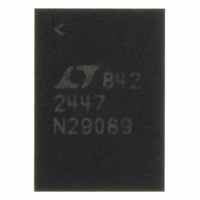LTC2447IUHF#PBF Linear Technology, LTC2447IUHF#PBF Datasheet - Page 26

LTC2447IUHF#PBF
Manufacturer Part Number
LTC2447IUHF#PBF
Description
IC ADC 24BIT 8CH HI SPEED 38QFN
Manufacturer
Linear Technology
Datasheet
1.LTC2446IUHFPBF.pdf
(28 pages)
Specifications of LTC2447IUHF#PBF
Number Of Bits
24
Sampling Rate (per Second)
8k
Data Interface
MICROWIRE™, Serial, SPI™
Number Of Converters
1
Power Dissipation (max)
40mW
Voltage Supply Source
Single Supply
Operating Temperature
-40°C ~ 85°C
Mounting Type
Surface Mount
Package / Case
38-WFQFN, Exposed Pad
Lead Free Status / RoHS Status
Lead free / RoHS Compliant
Available stocks
Company
Part Number
Manufacturer
Quantity
Price
APPLICATIO S I FOR ATIO
LTC2446/LTC2447
Figure 18a is a standard 350Ω, voltage excited strain gauge
with sense wires for the excitation voltage. REF01
REF01
sating for voltage drop along the high current excitation
supply wires. This can be a significant error, as the exci-
tation current is 14mA when excited with 5V. Reference
loading capacitors at the ADC are necessary to average the
reference current during sampling. Both ADC inputs are
always close to mid-reference, and hence close to mid-
supply when using 5V excitation.
Figure 18b is a novel way to interface the LTC2447 to a bridge
that is specified for constant current excitation. The Fujikura
FPM-120PG is a 120psig pressure sensor that is not
trimmed for absolute accuracy, but is temperature compen-
sated for low drift when excited by a constant current source.
The LTC2447’s fully differential reference allows sensing
the excitation current with a resistor in series with the bridge
excitation. Changes in ambient temperature and supply
voltage will cause the current to vary, but the LTC2447
compensates by using the current sense voltage as its
reference. The input common mode will be slightly higher
than mid-reference, but still far enough away from the
positive supply to eliminate concerns about the buffer
amplifier’s headroom.
Figure 18c is an Omega 44018 linear output thermistor. Two
fixed resistors linearize the output from the thermistors. The
recommended 5700Ω series resistor is broken up into two
2850Ω resistors to give a differential output centered
around mid-reference. This ensures that the buffer ampli-
fiers have enough headroom at the negative supply. Note
that the excitation is 3V, the maximum recommended by
the manufacturer to prevent self-heating errors. The
LTC2447 senses this reference voltage.
Figure 18d shows a standard 100Ω platinum RTD. This
circuit shows how to use the LTC2447 to make a direct
resistance measurement, where the output code is the RTD
resistance divided by the reference resistance. A 500Ω
sense resistor allows measurement of resistance up to
250Ω. (A standard α = 0.00385 RTD has a resistance of
247.09Ω at 400°C.)
26
–
sense the excitation voltage at the gauge, compen-
U
U
W
U
+
and
The LTC2446 multiplexes rail-to-rail inputs directly to the
ADC modulator and is suitable for low impedance resistive
sources such as 100Ω RTDs and 350Ω strain gauges that
are located close to the ADC. In applications where the
source resistance is high or the source is located more
than 5cm to 10cm from the ADC, the LTC2447 (with an
LT1368 buffer) is appropriate. The LTC2447 automatically
removes offset, drift and 1/f noise of the LT
consideration for single supply applications is that both
ADC inputs should always be at least 100mV from the
LT1368’s supply rails. All of the applications shown in
Figure 18 are designed to keep both analog inputs far
enough away from ground and V
operate on the same 5V supply as the LTC2447. Although
the LT1368 has rail-to-rail inputs and outputs, these
amplifiers still need some degree of headroom to work at
the resolution level of the LTC2447. For input signals
running rail-to-rail, the supply voltage of the LT1368 can
be increased in order to provide the extra headroom.
The LTC2446/LTC2447 reference have no such limitations
—they are truly rail-to-rail, and will even operate up to
300mV outside the supply rails. Reference terminals may
be connected directly to the ground plane or to a reference
voltage that is decoupled to the ground plane with a 1µF or
larger capacitor without any degradation of performance
provided the connection is less than 5cm from the LTC2446/
LTC2447. If the reference terminals are sensing a point
more than 5cm to 10cm away from the ADC, the reference
pins should be decoupled to the ground plane with 1µF
capacitors.
The reference terminals can also sense a resistive source
with a resistance up to 500Ω located close to the LTC2446/
LTC2447, however parasitic capacitance must be kept to
a minimum. If the sense point is more than 5cm from the
ADC, then it should be buffered. The LT1368 is also an
outstanding reference buffer. While offsets are not cancelled
as in the ADC input circuit, the 200mV offset and 2mV/°C
drift will not degrade the performance of most sensors. The
LT1369 is a quad version of the LT1368, and can serve as
the input buffer for an LTC2447 and two reference buffers.
CC
so that the LT1368 can
®
1368. One
24467fa











